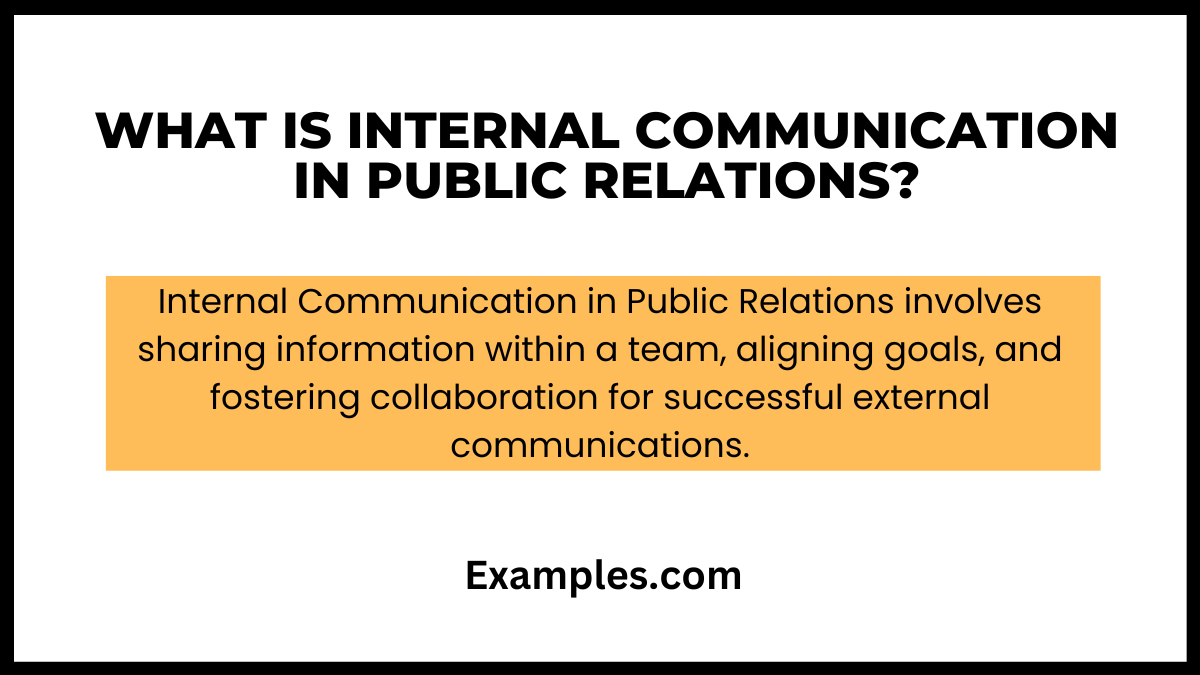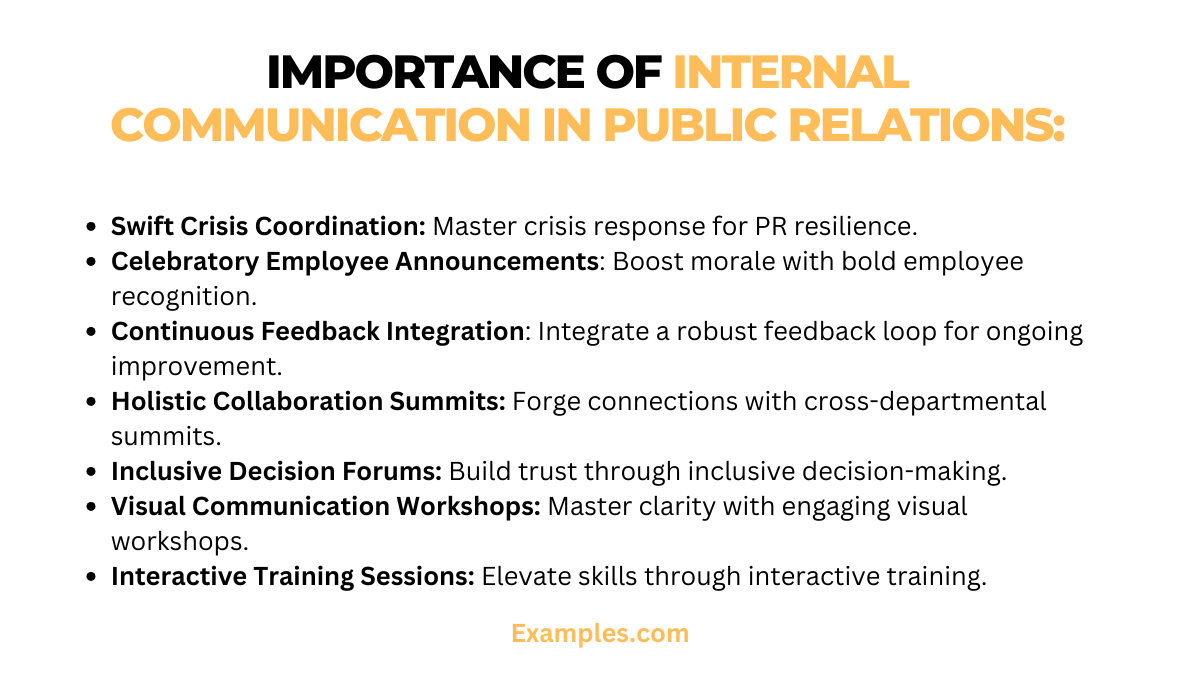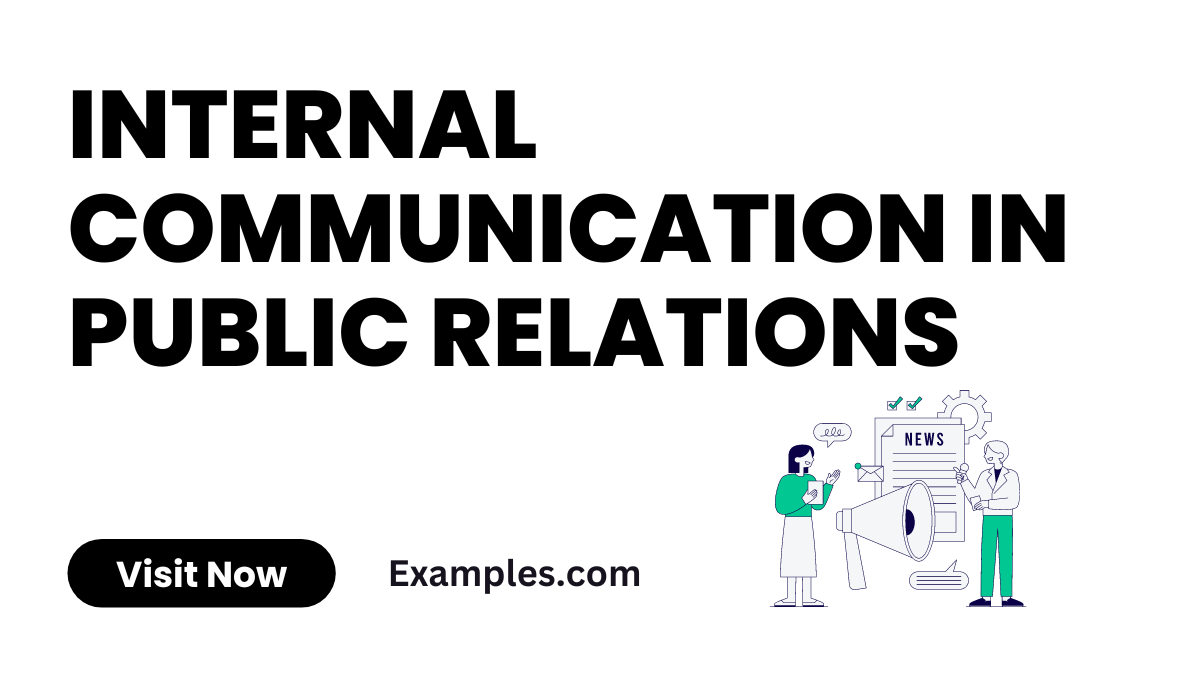14+ Internal Communication in Public Relations Examples
Unlock the keys to unparalleled success in Public Relations through our comprehensive guide on Internal Communication in Public Relations. This complete guide delves into the intricate dynamics of effective communication within the PR landscape, offering insights, strategies, and Communication Examples that transcend conventional approaches. Elevate your PR game as we explore the vital link between internal communication and public relations success. Dive into a wealth of knowledge to enhance your strategies and foster seamless collaboration within your PR team.
What is Internal Communication in Public Relations?

Internal Communication in Public Relations refers to the exchange of information, ideas, and messages within a PR team or organization. It plays a pivotal role in fostering collaboration, aligning goals, and ensuring a unified approach to external communications. In simple terms, it’s the vital link that connects team members, enabling them to work cohesively towards common PR objectives. This H2 heading serves as your gateway to a clear understanding of the fundamental concept of Internal Communication in Public Relations.
Best Example of Internal Communication in Public Relations:
XYZ Corporation excels in Internal Communication, fostering transparency and collaboration. Utilizing regular meetings, digital platforms, and targeted emails, the company ensures all team members are well-informed and aligned with PR goals. This approach reflects in cohesive external PR campaigns, showcasing a united team delivering impactful messages. Explore this H2 heading for insights into XYZ’s effective strategy, emphasizing the impact on Public Relations success.
15 Internal Communication in Public Relations Examples:

Delve into the world of effective Internal Communication in Public Relations with our comprehensive guide featuring 15 impactful examples. These real-world instances showcase the power of seamless communication within PR teams, highlighting diverse strategies and best practices. From fostering team collaboration to aligning goals,
1. Collaborative Brainstorming Sessions: In these sessions, team members engage in open discussions, fostering creativity and aligning PR goals. Enhance team synergy with bold brainstorming sessions.
2. Timely Email Updates: Regular email updates ensure everyone stays informed about PR initiatives, fostering a sense of unity. Master the art of clear and timely email communication.
3. Digital Platforms for Instant Messaging: Utilizing platforms like Slack for quick messages promotes real-time collaboration and ensures swift decision-making. Leverage digital platforms for instant and efficient messaging.
4. Inclusive Team Meetings: Regular team meetings provide a platform for inclusive discussions, ensuring everyone’s voice is heard. Transform team meetings into inclusive and impactful forums.
5. Clear Communication Plans: Structured communication plans outline PR strategies, ensuring a cohesive approach throughout the team. Craft clear communication plans for effective strategy implementation.
6. Interactive Training Sessions: Engaging training sessions enhance team skills and communication, contributing to PR success. Elevate team capabilities with interactive and effective training sessions.
7. Internal Newsletters for Updates: Creating internal newsletters keeps the team informed about industry trends and company updates. Curate engaging internal newsletters for insightful updates.
8. Peer-to-Peer Recognition Programs: Implementing recognition programs fosters a positive work environment, improving team morale and communication. Boost team spirit with bold peer-to-peer recognition initiatives.
9. Goal Alignment Workshops: Workshops on aligning individual goals with overall PR objectives contribute to team cohesion. Host goal alignment workshops for a united team vision.
10. Cross-Functional Collaboration: Encouraging collaboration across different departments ensures a holistic PR approach. Forge cross-functional collaboration bridges for comprehensive PR strategies.
11. Employee Feedback Channels: Establishing channels for constructive feedback promotes continuous improvement in communication strategies. Create effective channels for valuable employee feedback.
12. Crisis Communication Simulations: Simulating crisis scenarios helps the team practice swift and effective communication during emergencies. Prepare your team for crises with bold communication simulations.
13. Social Media Collaboration Platforms: Utilize platforms like Hootsuite for coordinated social media efforts, ensuring consistent messaging. Enhance social media strategies with collaborative platforms.
14. Employee Recognition Events: Organizing events to recognize employee contributions strengthens team bonds and communication. Celebrate achievements with bold employee recognition events.
15. Transparent Leadership Communication: Transparent communication from leadership builds trust and sets the tone for effective PR communication. Foster trust with bold and transparent leadership communication.
Importance of Internal Communication in Public Relations:

Understand the pivotal role of Internal Communication in Public Relations for strategic advantage. This guide explores the importance of fostering collaboration, aligning goals, and creating a seamless communication framework within your PR team.
- Swift Crisis Coordination: Master crisis response for PR resilience.
- Celebratory Employee Announcements: Boost morale with bold employee recognition.
- Continuous Feedback Integration: Integrate a robust feedback loop for ongoing improvement.
- Holistic Collaboration Summits: Forge connections with cross-departmental summits.
- Inclusive Decision Forums: Build trust through inclusive decision-making.
- Visual Communication Workshops: Master clarity with engaging visual workshops.
- Interactive Training Sessions: Elevate skills through interactive training.
- Project Milestone Updates: Communicate progress with bold updates.
- Strategic Communication Metrics: Enhance strategies with internal communication metrics.
- Visible Leadership Initiatives: Boost trust with impactful leadership visibility
Internal Communications: A Growing Type of Public Relations:
Discover the expanding role of Internal Communications within Public Relations and its transformative impact. This guide explores how cultivating strong internal communication practices amplifies your PR efforts, creating a solid foundation for organizational success. Dive into the evolving landscape of Internal Communications and learn how it shapes the narrative, enhances collaboration, and contributes to the overall growth of Public Relations.
- Interactive Internal Newsletters: Crafting newsletters with interactive elements engages employees and promotes information retention. Enhance engagement by transforming newsletters into interactive experiences.
- Inclusive Virtual Team-building Activities: Organizing virtual team-building events fosters camaraderie and effective communication among remote teams. Boost team morale through inclusive virtual team-building activities.
- Personalized Employee Recognition Platforms: Implementing platforms that personalize employee recognition enhances motivation and strengthens team bonds. Elevate morale with personalized employee recognition initiatives.
- Collaborative Idea Generation Platforms: Utilizing platforms for collaborative idea generation empowers teams to contribute to PR strategies creatively. Fuel innovation with bold collaborative idea generation platforms.
- Employee Feedback Webinars: Conducting webinars for employee feedback provides a platform for open communication and continuous improvement. Harness insights with impactful employee feedback webinars.
Why Internal Communication in Public Relations is Important at Workplace?
In the realm of workplace Public Relations, effective Internal Communication is paramount. Explore the key reasons why prioritizing internal communication is indispensable for the success of PR strategies.
- Fostering Collaboration: Enable seamless idea exchange and goal alignment for collective contributions to PR initiatives.
- Aligning Objectives: Ensure a unified approach by aligning individual and team objectives with overarching PR goals.
- Positive Work Culture: Cultivate transparency and efficiency to foster a positive workplace culture, directly impacting PR outcomes.
- Message Consistency: Guarantee consistent messaging across the team, promoting cohesion in external communications.
- Nurturing Creativity: Spark innovation and creative thinking within the team, enhancing the dynamism of PR campaigns.
- Crisis Preparedness: Establish a framework for swift and effective response strategies in PR crises through robust Internal Communication.
- Employee Engagement: Transform engaged employees into brand advocates, actively supporting and promoting PR initiatives.
- Transparency Builds Trust: Foster trust among team members through transparent communication, a foundational element for successful collaboration.
- Facilitating Feedback: Incorporate feedback mechanisms for continuous improvement in PR strategies based on insights from the team.
- Boosting Morale: Elevate morale by ensuring employees feel heard and informed, impacting commitment to PR excellence.
In conclusion, this guide illuminates the pivotal role of Internal Communication in Public Relations. By exploring examples and insights, it underscores the significance of fostering effective communication within teams for successful PR outcomes. Implementing these strategies is key to building a robust foundation that aligns goals, enhances collaboration, and elevates the overall impact of Public Relations initiatives.



